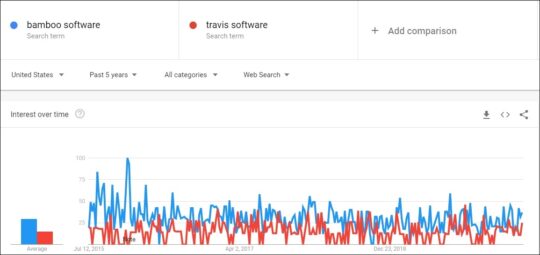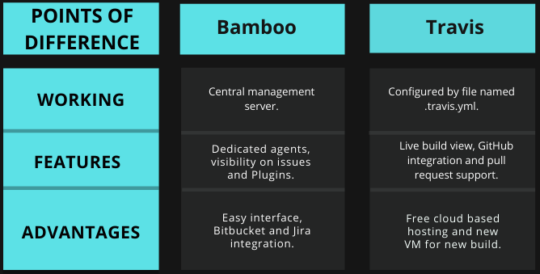With the help of continuous integration tools, developers aren’t so much worried about the delay in the delivery of projects.
Bamboo and Travis are two such continuous integration tools.
Bamboo is a continuous integration server.
It helps the developers by creating continuous delivery pipelines for scheduling and coordinating the work involved in developing or testing an application.
Travis is a hosted continuous integration service.
It helps the developers build and test the software hosted on GitHub and Bitbucket.
Let us differentiate the two on various parameters.
Exploring the difference between Bamboo and Travis

From the Google search results, it’s quite understandable that Bamboo is taking the lead in terms of user preferences.
Working of the Bamboo is dependent on the below-mentioned components of its workflow:
- Project: It contains specific plans and may be linked to multiple applications.
- Plan: It reserves all the functions that are to be performed.
- Stage: Initially, it might be having a single job, but, multiple jobs can be created with its help while dividing task lists into numerous jobs.
- Jobs: It runs in parallel with Stages. Multiple tasks can be performed on an agent with it.
- Tasks: It is the minimum capacity of work that an agent can do.
Bamboo works as a central management server.
It looks for the source through the source repository.
It then starts the build.
Once the solution is built, the user receives artifacts. Artifacts can be like executable files etc.
Multiple functions can be done on artifacts like zipping of these files, creating an MSI, installing them on a server for checking installations.
Working for Travis can be explained as under:
After the Travis CI is activated for secure storage.
Notifications from the GitHub will inform Travis about the new commits being pushed into this repository.
Travis CI can be used for a selective branch.
If it is being used for a selective branch, then Travis CI will inspect the particular branch and run it further in the .travis.yml.
Through this command, the software is built, and automated tests are run for further inspections.
Travis then notifies the developer in its configured property like sending the test reports etc.
Also Read: Jenkins vs. Docker: What’s the Difference?
Key features of Bamboo include:
- It supports multiple languages and technologies like Amazon S3 and AWS CodeDeploy.
- Dedicated agents help in running hotfixes and critical builds on the go. Also, the agent won’t entertain other activities unless it is dedicated to that task too.
- Visibility feature allows you to relook at the software issues and code changes if any. Supports plugins for other software.
- Users can customize build notifications based on the type of events.
Some of the features of Travis are as under:
- Live to build views.
- Availability of pull request support.
- Users get clean virtual machines for every build.
- Integration with GitHub.
- Supports platforms like Mac, Linux, and iOS.
Below mentioned are some of the benefits of using Bamboo:
- It supports integration with Bitbucket and Jira.
- Easy interface.
- Light weighted and easily customizable.
- Users can run automated tests on new codes.
- It will automatically detect the new branch and build it.
Some of the pros of Travis are mentioned below:
- Quick notifications on build failure.
- Running of cluster test in parallel.
- Best for open-source projects.
- Cloud-based hosting is free.
- For every new build user gets a new VM.
Below mentioned are some of the reviews for Bamboo taken from trustradius.com
- AppFusions
AppFusions was able to complete the functions like automatically building code base and deploying built cases to target the environment.
- eSilicon
eSilicon software team uses it for continuous deployments as well as integrations.
They were also able to have control and visibility over every process with Bitbucket and Jira's help, which easily integrates with Bamboo.
Below mentioned reviews for Travis have been taken from Travis CI’s testimonial section.
- Rails
Rails were able to catch issues quickly with the help of Travis.
With the help of Travis CI, it was easy for them to coordinate commits and contributors flowing through the Rails codebase.
TwitterOSS uses Travis CI for its open-source projects on GitHub.
TwitterOSS finds Travis CI API and container infrastructure for speedier builds quite useful.

Conclusion
Both Bamboo and Travis are really good options.
However, choosing among the two entirely depends on the type of projects, hosting needs, and the concern for maintenance as well as support there is.
Also Read: TeamCity vs. Octopus: What’s the Difference Between the Two?




